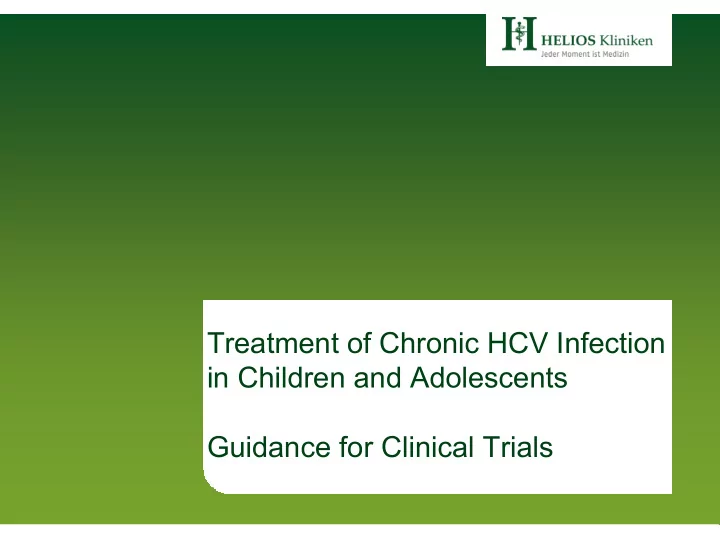

Treatment of Chronic HCV Infection in Children and Adolescents Guidance for Clinical Trials
Background Information • Low prevalence in industrialized countries; vertical infection almost exclusive mode of transmission; estimated number of infected children in Europe: 500 – 600 with declining trend • Spontaneous viral elimination up to 4 years of age approximately 10 – 25%, depending on genotype and route of infection • Low disease progression, histologically mild inflammatory activity and fibrosis, but steatosis may be a prognostic factor 1 Stefan Wirth Hospital for Children and Adolescence, HELIOS Klinikum Wuppertal, Witten/Herdecke University
PEG-IFN- 2b (PegIntron ) und Ribavirin (Rebetol ) (15 mg/kg x Tag) PEG-IFN-a2a (Pegasys ) und Ribavirin (Rebetol ) (15 mg/kg x Tag) SVR * Wirth S et al, J Hepatol 2010, ** Sokal E et al, J Hepatol 2010 , # Schwarz et al, Gastroenterology 2011 Schwarz # 2011 Wirth 2005 Jara 2008 Wirth 2010* (SPRI) Total Sokal 2010** Dosage 1,5 µg/kgxWo 1,0 µg/kgxWo 60 µg/m²xWo 180 µg/1,73 m²/week 100 µg/m² Total 36/61 (59%) 15/30 (50%) 70/107 (65,4%) 121/198 (61,1%) 29/55 (53%) 43/65 (66,1%) Genotype 1 22/46 (48%) 12/26 (46%) 38/72 (53%) 72/144 (50%) 21/45 (47%) 27/47 (59%) 2/3 13/13 (100%) 3/3 (100%) 28/30 (93%) 44/46 (96%) 8/10 (80%) 16/17 (94%) 4 1/2 0/1 4/5 (80%) 5/8 (62%) Included in G1 ALT-levels Elevated 12/25 (48%) 27/44 (61%) 19/33 (58%) Normal 24/36 (67%) 42/63 (67%) 24/30 (80%) Mode of infection Parenteral 19/27 (70%) 7/9 (78%) 5/5 (100%) 31/41(76%) Genotype 1 13/21 (62%) 1/1 Vertical 12/25 (48%) 8/21 (38%) 46/75 (61%) 66/121 (55%) Genotype 1 7/20 (35%) 26/52 (50%) 33/72 (46%) Break through 9,8% 6/41 (15%) Relaps 7,7% 8% 6/35 (17%) 2 Stefan Wirth Hospital for Children and Adolescence, HELIOS Klinikum Wuppertal, Witten/Herdecke University
Improved Treatment ist needed In conclusion: „Despite considerable progress in the treatment of children with chronic hepatitis C, 40-50% of the patients with genotype 1, which represents the majority of infected individuals, treatment remains unsuccessful“ 3 Stefan Wirth Hospital for Children and Adolescence, HELIOS Klinikum Wuppertal, Witten/Herdecke University
Aims and Criteria for Treating Children with Chronic Hepatitis C • Treatment in early childhood is feasible and very well tolerated. • Primary endpoint is SVR and clinical cure. • Relieve psychological burden of disease for the patient and families, eliminate the social aspects of having a blood borne disease. • The aim is not the treatment of a severe ongoing liver disease, but the prevention of a future one. Guidance for Clinical Trials for Children and Adolescents With Chronic Hepatitis C, JPGN 2011; 52:233-7 4 Stefan Wirth Hospital for Children and Adolescence, HELIOS Klinikum Wuppertal, Witten/Herdecke University
Inclusion Criteria for Treating Children with Chronic Hepatitis C Guidance for Clinical Trials for Children and Adolescents With Chronic Hepatitis C, JPGN 2011; 52:233-7 • All children with chronic HCV infection with a measurable HCV- RNA level should be considered • Treatment is not indicated before the age of three years • Stratification according genotypes is necessary • Two age groups are recommended for documentation and analyses (3 - 10, 10 - 18 years) • Treatment during rapid growth spurt or puberty should be avoided, if possible (but is no contraindication!) • Children with previous treatment failure could be included 2 years after the end of treatment • A baseline liver biopsy is recommended but not mandatory 5 Stefan Wirth Hospital for Children and Adolescence, HELIOS Klinikum Wuppertal, Witten/Herdecke University
Study Drugs • The drug to be tested should have demonstrated noninferiority to present SOC • No need for a placebo arm • Test drug could be used in triple combination with peg-IFN and riba or as monotherapy • Oral treatment would be desirable (proper formulation needed) • Primarily focus on patients infected with genotype 1 (naive and non-responders) • Improved efficacy: increased viral clearance rate, or the same SVR with a shorter treatment duration or less side effects 6 Stefan Wirth Hospital for Children and Adolescence, HELIOS Klinikum Wuppertal, Witten/Herdecke University
Study Drugs • The drug to be tested should have demonstrated noninferiority to present SOC • No need for a placebo arm • Test drug could be used in triple combination with peg-IFN and riba or as monotherapy • Oral treatment would be desirable (proper formulation needed) • Primarily focus on patients infected with genotype 1 (naive and non-responders) • Improved efficacy: increased viral clearance rate, or the same SVR with a shorter treatment duration or less side effects 7 Stefan Wirth Hospital for Children and Adolescence, HELIOS Klinikum Wuppertal, Witten/Herdecke University
Recommended baseline investigations before HCV treatment Clinical examination • Physical and neuropsychiatric examination, Tanner pubertal stage • Evaluation of growth parameters, z-scores for height and weight, BMI, waist circumference, if possible: growth velocity before starting treatment • Description of co-morbidities Morphologic investigations • Liver Ultrasound • Liver histology – assessed by Ishak or Metavir scores • Bone age (> 7 years of age) Laboratory tests • Complete red and white blood count, reticulocytes, ALT, AST, gammaGT, AP, bilirubin, albumin, coagulation, Alpha-feto protein, BUN, creatinine, Immunoglobulins, autoantibodies (ANA; LKM1), Ferritin, TSH, thyroid-antibodies, HOMA index, Pregnancy test, anti-HCV, quantitative HCV RNA, genotype 8 Stefan Wirth Hospital for Children and Adolescence, HELIOS Klinikum Wuppertal, Witten/Herdecke University
Recommended investigations during/after HCV treatment Parameter Repeat frequency Physical and neuropsychiatric examination Every visit Tanner pubertal stage Every 3 months Evaluation of growth parameters, z-score for height and Every 3 months weight, BMI, waist circumference Growth velocity Every 6 months Bone age End of trial Laboratory tests Complete red and white blood count, Every month during the first 3 Alb, ALT, AST, gammaGT, AP, bilirubin, coagulation months, then every 3 months Every 3 - 6 months Reticulocytes, , albumin, BUN, creatinine, immunoglobulins, autoantibodies (ANA; LKM1), ferritin, TSH, thyroid-antibodies Five year follow-up after treatment Quantitative HCV RNA, 4, 8, 12 weeks, then every 3 months 9 Stefan Wirth Hospital for Children and Adolescence, HELIOS Klinikum Wuppertal, Witten/Herdecke University HOMA index End of treatment
Recommend
More recommend